MALARIA

malaria mosquito Malaria is a disease caused by single-cell parasitic protozoans that are transferred to humans by particular kinds of mosquitos. It a can damage the nervous system, kidneys and liver. Severe cases can quickly lead to death. The word “malaria” is derived from the Italian words “mala aria” , which means "bad air" and is based on the mistaken belief in the past that the disease was caused by bad swamp air. [Source: Michael Finkel, National Geographic, July 2007]
Malaria is a parasitic infection transmitted by Anopheline mosquitoes. It causes an estimated 219 million cases globally, and results in more than 400,000 deaths every year. Most of the deaths occur in children under the age of five. This better than before but still bad. Malaria affected up to 300 million people and killed nearly 800,000 every year in the early 2000s, twice as many people as in the 1980s. [Source: World Health Organization (WHO), March 2, 2020]
Malaria is one of the world's deadliest diseases and the world's number one parasitic killer. Endemic in 106 nations and threatening half the world’s population, its threat is greatest in Africa, where the WHO says a child dies of malaria about every 45 seconds. About 90 percent of the victims are children under 5 in poor countries in Africa. A child dies of malaria every 12 to 30 seconds and about 25 percent of all childhood deaths in the Third World are the result of malaria. India, Myanmar, Papua New Guinea and Indonesia are among the Asian countries with the highest numbers of cases and deaths.
Jerry Adler wrote in Smithsonian magazine: “A. gambiae has been called the world’s most dangerous animal, although strictly speaking that applies only to the female of the species, which does the bloodsucking and harms only indirectly. Its bite is a minor nuisance, unless it happens to convey the malaria parasite, Plasmodium falciparum, for which it is a primary human vector. [Source: Jerry Adler, Smithsonian magazine, June 2016]
Malaria-carrying mosquitos have probably dispatched more humans than all the wars in history. In the history of the world only the plague (and perhaps someday HIV) have been as deadly and destructive. Malaria also costs developing countries billions of dollars in lost wages, business and tourism every year. The cost in Sub-Saharan Africa alone, where it is not uncommon for poor families to spend a quarter of their income on malaria treatment, may be as much as $30 billion according to the United Nations.
Malaria is most common in sub-Saharan Africa and Southeast Asia. It is found mostly in tropical regions, especially in swampy areas or places where there is a lot of still water (where malaria-carrying mosquitos breed). Often incidences of the disease are highest in the wet season. The London School of Hygiene & Tropical Medicine has traditionally been a leader in malaria research.
See Separate Articles:VECTOR-BORNE DISEASES CAUSED BY MOSQUITOES, TICKS AND FLIES factsanddetails.com; MOSQUITOES factsanddetails.com COMBATING MALARIA: NETS, DIRTY SOCKS, DNA AND VACCINE EFFORTS factsanddetails.com; ARTEMISININ AND MALARIA MEDICINES, TREATMENTS AND DRUGS factsanddetails.com; MALARIA ERADICATION AND DDT factsanddetails.com
Websites and Resources Centers for Disease Control and Prevention (CDC) cdc.gov/DiseasesConditions ; World Health Organization (WHO) fact sheets who.int/news-room/fact-sheets ; National Institute of Health (NIH) Library Medline Plus medlineplus/healthtopics ; Merck Manuals (detailed info many diseases) merckmanuals.com/professional/index ; Global Fund to Fight AIDS, TB and Malaria theglobalfund.org Book: “The Fever: How Malaria Has Ruled Humankind for 500,000 years” by Sonia Shah (2010, Sarah Crichton Books, Farrar, Straus & Giroux).
Declining Malaria Deaths

quinineMalaria cases and deaths have been dropping since 2004, due largely to big campaigns to distribute bednets, spray homes with insecticide and make better drugs available. The World Health Organization reported about 655,000 had died from the disease in 2010, when it was still the world's fifth biggest killer in low-income countries. Deaths are estimated to have dropped from nearly a million in 2000 to 781,000 in 2009.
Jerry Adler wrote in Smithsonian magazine: “ Although a huge international effort cut malaria mortality by about half between 2000 and 2015, the World Health Organization still estimates there were more than 400,000 fatal cases in 2015, primarily in Africa. Children are particularly susceptible. The Bill and Melinda Gates Foundation prioritized malaria in its more than $500 million commitment to fight infectious disease in developing countries. [Source: Jerry Adler, Smithsonian magazine, June 2016]
According to AFP: The death toll from malaria has been declining in Africa — the part of the world worst hit by the disease — in recent years, largely due to the increased use of artemisinin drugs and the widening distribution of insecticide-treated bed nets. But if resistance spreads to artemisinin therapies — used alone or taken in combination with other anti-malarials — some experts are concerned that a resurgence of drug-resistant malaria could return to Africa. [Source: AFP, April 5, 2012]
“Researchers say a new anti-malaria drug is not expected to appear on the world market before the next decade is up. The two studies were funded by the Wellcome Trust and the US National Institutes of Health, and included scientists from Mahidol University, Bangkok; the Center for Tropical Medicine at Britain's Oxford University; and the Texas Biomedical Research Institute in the United States.
Origins of Malaria — From Gorillas or Chimpanzees?
Michael Specter wrote in The New Yorker: “The origins and the evolutionary history of the” malaria “parasite have always been murky. Because malaria is so widespread among humans, and so deadly, for years the most common scientific theory held that humans passed the disease to other primates. To test the hypothesis, Stephen Rich, of the University of Massachusetts, and others examined the genetic structure of a hundred samples of the chimpanzee version of the malaria parasite—P. reichenowi. They identified eight strains that collectively were far more genetically diverse than the human form. In fact, P. falciparum could, in most cases, be constructed from the genes of the chimp virus. That could only mean that the human form came from chimps, not the other way around. [Source: Michael Specter, The New Yorker, December 20, 2010]
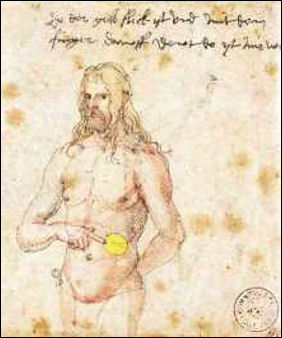
Durer drawing of
malaria spleenMaggie Fox of Reuters wrote: “Malaria appears to have jumped to humans from gorillas, and the parasite may have spread globally from a single gorilla to a single human, researchers reported. DNA from the droppings of nearly 3,000 apes — gorillas, chimpanzees and bonobos — shows the strain of malaria parasite most common in humans is virtually identical to one of many strains that infects gorillas.It is far more distant than strains affecting chimps and their close cousins, the bonobos, Beatrice Hahn of the University of Alabama at Birmingham and colleagues reported. [Source: Maggie Fox, Reuters, September 22, 2010]
Hahn and colleagues used ape droppings collected to study the origins of the AIDS virus for their study, published in the journal Nature. Hahn's team tested genetic material from the human immunodeficiency virus for malaria parasites, including the Plasmodium falciparum parasite that causes most human cases."Wild apes, in particular the common chimps and the western gorillas, are naturally infected with at least eight or nine different Plasmodium species," Hahn said.
For years chimps were the chief suspects. But Hahn's data shows that gorillas, and only gorillas, are infected by a Plasmodium species virtually identical on the genetic level to the type that infects humans. "Now, how many mosquitoes were biting however many humans or gorillas I do not know," Hahn said. "But the end result is, based on sequence analysis of 105 human Plasmodium parasites, it looks like there was a single transmission." In other words, the parasite only had to infect one person or a small group of people before quickly taking hold and spreading to much of the world.
Slutsker said the parasite may not necessarily have spread to people from apes via a mosquito. It can also be spread by direct blood transfer — perhaps while a gorilla was being butchered for food. Many experts believe this is how HIV first spread to humans. What the researchers cannot say is when this happened. HIV mutates — evolves — quickly and these changes can be used as what is known as a molecular clock to date changes. Malaria parasites change much more slowly, Edward Holmes of Pennsylvania State University wrote in a commentary on the Nature study.
Early History of Malaria
Malaria infects bats, snakes, birds, lemurs, monkeys and mice as well as humans. An ancient disease, it probably killed man’s earliest ancestors and may have infected the dinosaurs. Some scientists believe that one out of two people who have ever lived died of malaria. The species of mosquito that causes yellow fever and malaria are believed to have diverged about 150 million years ago.
The ancient Egyptians, Chinese and Greeks are all believed to have suffered from malaria. Some Egyptian mummies show signs of it. Symptoms of the disease were described by Aristotle, Homer, Socrates and Hippocrates and in Nei Ching, the Chinese canon of medicine, which dates back to 2700 B.C. The decline of some Greek city states and the fall of Rome have been attributed to malaria. Alexander the Great likely died of malaria. It may have stopped the armies of Attila the Hun and Genghis Khan. See the Fall of Ancient Rome

quinine cinchona Malaria remained a problem the Middle Ages, Renaissance and Enlightenment. Oliver Cromwell and the Italian poet Dante are thought to have died of it and Shakespeare alludes to it in eight of his plays. In Europe malaria spread as far north as London and Russia. In the New World it made it way to Montreal and Boston. Among the remedies taken in Europe were viper’s broth, crab’s eyes, live spiders worn on a necklace and dead spiders congeal in butter.
The first malaria relief known in the West was derived from the bark of South American cinchona tree, a remedy used by the Incas to prevent malaria and introduced to Europe by the Spaniards as a treatment for the disease. A close cousin of coffee, the cinchona tree is naive to Ecuador and Peru. Local people called it “ quina quina” (“bark of barks”).
The tree was named after the Countess Chinchon, a Spanish countess who was cured of malaria with the bark while visiting Peru and was so grateful she distributed the bark for free to the poor of Lima and brought some back to Spain. The story is nice but more likely the bark was introduced to Europe by a Jesuit missionary. In 1632 it reached Italy and quickly the demand became overwhelming. Harvested by indigenous laborers, it was carried to the Pacific coast and shipped to Europe, where it was sold for a fortune.
Both Europeans and Americans were dependent on Peru and Bolivia, which controlled the quinine market, the only known treatment against the disease. Many died in treks over the Andes into the clouds forest where the cinchona trees thrived in an effort to bring back seeds and saplings of the plant. It wasn’t until the 1800s that the cichona tree was successfully raised outside of South America — on plantations in India, Sri Lanka and Java.
In 1829 quinine was purified from the chinchona bark. It works by disrupting the parasite’s reproduction. It saves thousands maybe millions of lives but had many drawbacks. It was effective for only a short time. Among it side effects were hearing loss.
Later History of Malaria

malaria in the U.S. In the 18th and 19th century malaria racked southern Europe and the United States in epidemic proportions. George Washington, Abraham Lincoln and Ulysses S. Grant all suffered from it. Foggy Bottom in Washington D.C. refers to the malaria miasma that clung to the wetlands around the Potomac. Malaria in the nation’s capital was so bad some suggested putting a wire fence around it. A million Union Army casualties were attributed to malaria.
The British suffered terrible from malaria in India. To avoid the disease they established hill stations and added quinine to their gin and tonics. The full scale conquest of Africa by Europeans did not take place until quinine was widely used there as a malaria prophylactic. See Africa, India.
In 1897, Ronald Ross, a British physician working for the Indian Medical Services in Hyderabad, India discovered that malaria was carried by a mosquito. He dissected an anopheles mosquito that had just fed on a malaria patient and found the P. flacipaurm inside it. He won a Nobel prize in 1902 for his work.
Until the 1940s, malaria was found throughout Europe, Asia and the Caribbean and was common in Italy and Spain and the Mediterranean region. The American campaign in Italy in 1943 was slowed more by malaria than it was by war wounds, Nazis or Italian troops. In the Pacific theater of World War II, casualties from malaria exceeded those from combat.
The Center of Disease Control was set up in Atlanta not Washington at the end of World War II with the primary mission of controlling malaria because the disease was still very much a problem in the American South at that time. Malaria was eradicated in the United States in 1951 thanks mainly to DDT( See DDT Below). Chloroquine, the first synthetic malaria medicine, was developed in the 1940s. It was cheap, safe, effective and long-lasting — and was nothing short of a miracle drug.
Malaria and Africa
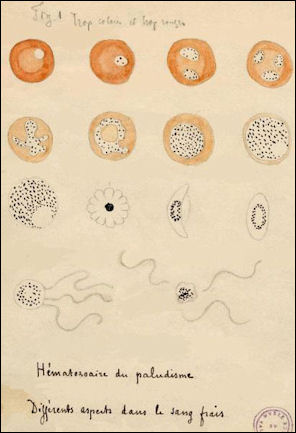
Laveran malaria drawings Sub-Saharan Africa accounts for nine out of 10 malaria deaths, mainly children under age 5. At its peak as many as 1 million children under the age of five were killed by the disease there every year, with as many as one in 20 children dying in places where the disease is especially endemic. Even though Africa has alarming AIDS infection rates, many doctors say malaria is a much more serious problem. Many malaria sufferers also have HIV or tuberculosis. Getting one disease makes it easier to get the others.
As of 2010, 42 percent of African households owned at least one insecticide-treated mosquito net. But the rate remained low in Nigeria and Democratic Republic of Congo, which have Africa's highest death rates from malaria, a WHO report said. [Source: Stephanie Nebehay, Reuters, December 14, 2010]
In the 2000s, an African child had an average of between 1.6 and 5.4 episodes of malarial fever each year. Surprisingly, though, the disease accounted for population rises rather than decline as couples have six or seven children to ensure that three or four survive. At that time malaria cost Africa $12 billion a year, or 40 percent of it public health spending. No anti-poverty program in Africa can be regarded as adequate unless it also addresses the malaria problem there. According to WHO study, malaria is expected to cause the economies of countries where the disease is endemic to shrink by 20 percent over 20 years. Some estimate $3.2 billion a year is needed to prevent and control malaria in Africa. In 2004 only $600 million was spent.
In some parts of Africa, residents receive an average one infectious bite a day even if they take precautions such as using bed nets and window screens. During the rainy season its is not unusual for entire villages to get struck down by disease, with villagers lying, shaking and sweating in bed, too ill to work, eat or even stand up, and weakened for the rest of the year. The disease is exceptionally common where people live in mud huts, which constantly have to be replastered with mud dug from holes, which fill up with stagnant water.
Many Africans have built a resistance to malaria but still regularly come down with the disease anyway and receive minimal or no treatment when they do. Most places don’t even have microscopes needed to check for protozoa and correctly diagnose the disease. If someone has a fever it is simply assumed they have malaria. Malaria prophylactics are rarely used. They are fine for tourists visiting for a few week or two but for long term use by local people: they have too many bad side effects and are too expensive.
Malaria Parasites

knowlesi Malaria is caused in humans by four single-cell parasitic protozoans of the genus “ Plasmodium” . It is transferred from person to person by a form of the protozoans called gametocytes that are extracted from a human victim's blood and transferred to other humans by the “ Anopheles “ species of mosquito.
The plasmodia live in the mosquito’s saliva and enters the human host when the mosquitos sprays saliva into the host’s blood to inhibit coagulation. About 50,000 plasmodia can fit on a period in this sentence. Usually dozens enter the bloodstream. Only one is necessary to kill a person. They are in the blood stream for a few minutes riding the blood flow to the liver, where they burrow into liver cells.
The malaria parasite is quite sophisticated. While the viruses that cause polio, measles and even HIV are made up just a few genes, malaria protozoa has more than 5,000 genes. This high number allows it mutate and fend off threats form new drugs. The protozoa’s greatest asset for survival is its ability to defeat the human immune system by continually changing its surface proteins and its location in the body.
Malaria Mosquitos
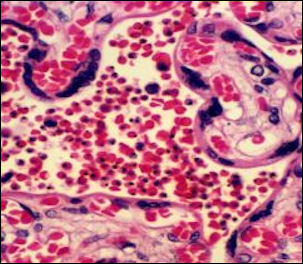
infected placental malaria Anopheles gambiae mosquitoes are the primary vectors (carriers) of malaria. Anopheles exist on every continent except Antarctica, but most malaria-related deaths take place in Africa, where Anopheles gambiae lives. These mosquitos are typically found in shallow, sunlit puddles in sub-Saharan Africa, but it can survive in any number of wet places if the temperature is around 27 degrees C (80 degrees F). [Source: Jerry Adler, Smithsonian magazine, June 2016]
Malaria mosquitos need to drink blood every three days, They are most active in the rainy season and are attracted by the odors and warmth of human bodies. A single feeding can last 10 minutes, with the mosquito ingesting 2½ times its pre-meal weight. Malaria thrives in tropical areas where the climate is right for the specific mosquitos that carries the disease and there is a lot of rain and stagnant pools of water for mosquitos to breed.
There are at least 60 species of “ Anopheles” worldwide. The “ Anopheles gambiae” , native to Africa, spreads the diseases because it bites human 95 percent of the time. “ Anopheles freeborni” , found in the United States, is capable a of giving a more potent dose of the disease but is poor vector because it prefers animals to humans.
“ Gambiae” breed in stagnant water and are particularly effective spreading disease. They gather in neighborhoods and villages at night, slip into houses at dusk and bite quietly at night. They digest their "blood meal" while resting on the walls of the house and slip away by the morning. Jerry Adler wrote in Smithsonian magazine: ““To the naked eye, the egg of the Anopheles gambiae mosquito is just a dark speck, but under a 100-power microscope, it shows up as a fat, slightly curved cucumber, somewhat narrower at one end.
In 2002, scientists published the genome — a map of all the DNA — of the mosquito that carries malaria. It turns out the genetic make up of this mosquito is less complex than for the one that carries yellow fever and dengue fever.
Malaria Cycle

cells infected with malaria
Malaria is transferred to humans by the female “ Anopheles” mosquito. Each person who has malaria has the potential of infecting hundreds of others as each mosquito that bites him or her can carry the disease to several other people.
The malaria cycle begins when: 1) The female mosquito gets a stomach is full of blood and starts producing eggs and mates. When she bites a human about 50 sporozoites — the free-swimming form of the malaria parasite — are transferred through the mosquito's salivary glands to the blood stream of her victim.
2) Inside their human host, the sporozoites move to the liver and take up residence in a small area there and eat and multiply non-stop until each parasite that entered the body has replicated itself about 40,000 times. Though they can remain there for many years, the sporozoites usually mature and rapidly multiply asexually over a period of less than four weeks, producing offspring known as meroziotes. It takes about a week or two from the time a human host is bitten to the time when he get sick. Several dozens sporozites can produce produces millions of meroziotes.
3) When the liver cells reach their capacity they rupture, releasing meroziotes into the bloodstream, where they invade red blood cells and feed on hemoglobin, growing and deforming the cells they come in contact with, causing malaria. It takes only about 30 seconds for the meroziotes to expand out of the liver into the bloodstream and find red bloods cell to drill into. Over two days they devour the cell and then burst out again into the bloodstream. This is when the body’s defense begin to respond and the host first begins to feel sick.
Two or three days after the red blood cells are invaded they rupture, releasing new meroziotes which attack more red blood cells. Each time the red blood cells rupture the victim experiences a bout of fever. At this stage the body may contain 30 billion meroziotes or more. If a person is infected for the first the response of the immune system is too little too late: and the reproduction cycle of malaria continues at an exponential pace until there are billions of parasites. The symptoms in host intensify and he can become so feverish he almost boils to death.
4) Within the red blood cells some meroziotes develop into a sexual form of the microbe called gametocytes, which do not produce symptoms in the human body but are transferred to the mosquito when the mosquito bites. The sexual meroziotes reproduces in the mosquito's stomach, producing, zygotes which invade the mosquitos mid gut, producing oocysts. The oocysts release sporozoites. If these sporoziotes enter a new human victim and a new cycle begins.
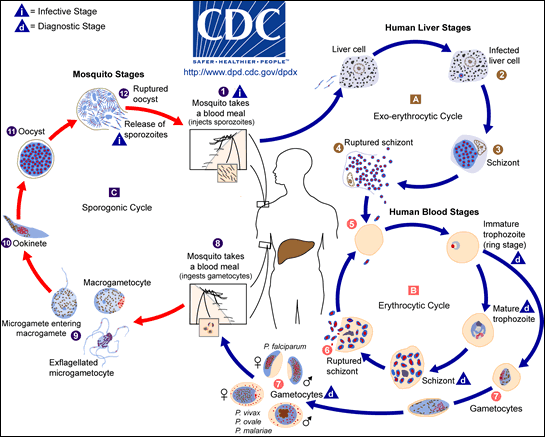
Malaria life cycle
Types of Phasmidia
There are dozens of different kinds of Phasmidia. The four types that infect humans with malaria are: 1) falciparum, 2) vivax (three day), 3) malariae (four-day), and 4) ovale (egg-shape). “ Plasmodium vivax “ and to a lesser extent “ Plasmodium falciparum “ are the most common forms of the malaria-causing protozoans. “ Plasmodium falciparum” account for more than 90 percent of the world's malaria. It is found mostly in Africa.
Vivax” is found mostly in South America and Asia. It gets it name from the intense way the merozoites vibrate inside the red blood cells. It is the hardiest form of malaria but is les dangerous to humans than “ Plasmodium falciparum” . It can survive in nontropical regions and withstand a variety of anti-malaria drugs.

falciparum “ Plasmodium falciparum” is the most lethal and prevalent form of malaria. Found in Africa, Latin American and Asia, it accounts for half of malaria cases worldwide and 95 percent of malaria deaths. It is the only type of malaria that infects the brain. About 1 percent of the people infected by it die and can strike with shock and awe speed and power. It is not unheard of children with “Plasmodium falciparum” to go to school in the morning and die in the afternoon.
“Plasmodium falciparum” thrives in the hot, moist areas of sub-Saharan Africa and Southeast Asia. Named for the scimitar shape the parasite gives red blood cells it attacks, it causes severe anemia and occludes the blood flow through capillaries in vital organs, which can causes death.
Carbon dioxide exhaled from human attracts the mosquitos. Studies have shown that the plasmodium are able to manipulate mosquitoes’ behavior by making infected human smell more attractive to them when the plasmodium is ready to be transferred into a humans blood and making humans smell less attractive when it is not advantageous for them to bite. Some wonder whether the plasmodium might also be able to manipulate humans in subtle ways.
Malaria Symptoms
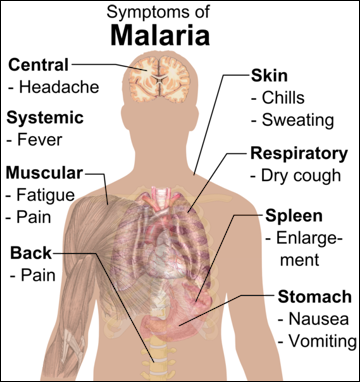
Malaria symptoms Malaria usually begins with the sudden onset of violent chills followed by a very high fever, often accompanied by crippling headaches, convulsions and delirium.. The wife of one victim told Smithsonian, "It is a terrible thing to have. Sweating. Very bad headaches. High, high fever. You vomit. You are so weak...when malaria comes every few days, you feel like you want to die."
The symptoms usually appear 10 to 15 days after a person is infected. The telltale malaria symptom is an enlarged spleen. The fever can be up to 108̊F. Other symptoms include malaise, joint pain, muscular aches and diarrhea. Some people with malaria fall unconscious or shake so badly they have to be tied to their bed to keep from falling off. Others produce urine stained red from hemoglobin released from their exploding red blood cells. Anemia is common because the malaria parasites thrive by eating the red blood cells they infect.
Parasites feeding on oxygen-carrying hemoglobin in the blood cause blood cells to stick to blood vessel walls, and, in serious cases, blocking the flow of blood and damaging the brain, liver, kidneys and other organs. This can cause respiratory distress, kidney failure, bleeding disorders and other degenerative ailments. Children die because they are much more vulnerable to anemia and convulsions.
Malaria symptoms can appear as soon as 8 days or as long as several months after infection. Attacks may subside and reoccur periodically throughout one’s life. People who get the disease repeatedly have less severe symptoms each time but are very tired and lethargic each time it strikes. Regular bouts of the disease may lead to life-threatening anemia, delirium, respiratory failure. coma or death from exhaustion.
Cerebral Malaria

Gametocytes plasmodium One of the worst kinds of malaria is cerebral malaria. Protozoans attack blood cells in their brain and stick to cell walls there, blocking the blood flow. Victims are often so debilitated they lie absolutely still and have difficultly opening and closing their eyes. Ten percent of cases result in permanent brain damage and another 10 to 50 percent of victims die.
In cases of cerebal malaria, "falciparum", infected cells grow Velcro-like knobs that allow them to pass through the capillaries of the brain, where they attach themselves. For reasons that are not understood, the presence of the parasites causes the brain to swell. This is when malaria is at its deadliest. So many red blood cells have been attacked that oxygen fails to reach vital organs. The heart has difficulty beating, the lungs fail to function. The blood becomes acidic. The victim begins convulsing and falls into a coma.
National Geographic described the treatment of three-year-old named Methyline with cerebral malaria who was admitted to Zambia’s Kalene Mission Hospital. The night report read: “Admitted yesterday...Fevers and seizures. Malaria.” The right side of Methyline’s head was saved and an IV line was inserted. Multiple doses of quinine were given. [Source: Michael Finkel, National Geographic, July 2007]
Michael Finkel wrote in National Geographic, “For almost a week Methyline languished in a coma. A malarial coma can be a horrible thing to observe: arched back, rigid arms, twisted hands, pointed toes. A still life in agony.” Reports written by her hurses read: “Unconscious. Continues on IV quinine.” “Still unconscious, though not seizuring.” “Still unconscious.” After the seizures returned an aide wrote, “I was worried so I informed Sister [a senior nurse], who came and ordered Valium, which was given with relief.” [Ibid]
After a while Methyline’s condition improved. “She’s opening her eyes but she still looks cerebral.” “Drinking and eating porridge.” And then: “Is conscious and talking!!” Three days later she was released from the hospital “looking bright” but “Still not walking well.” Her walking problems were a sign hat she may have some permanent neurological damage. [Ibid]
Methyline was fortunate. The log for a young patient who was not read: “the patient is in bad condition. Grunting and weary. Irregular breathing. Sister was informed. Midnight she collapsed and died. The body was taken home. May her soul rest in Peace.” Another: “Semi-conscious. IV for quinine. Seizure. Valium. Pain suppository. Fever. More pain suppository. At 0500 hours, child had gasping respiration. Finally, child suddenly collapsed and died. His body was taken home.”
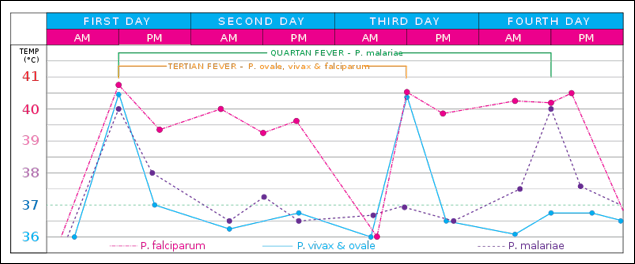
Malaria fever
Malaria, Health and Poverty
Research has shown that malaria increases the likelihood that an HIV-infected person will pass on the AIDS virus to others. Many people with malaria also have worm infections, which place a heavy burden on the body.
Malaria is particularly destructive in pregnant women and children because of their weak immune systems. The very young can die within 24 hours of the first onset of symptoms.
Malaria is arguably the disease most responsible for the poverty trap in the developing world. Poor health and poverty create a cycle that is debilitating and hard to break. Els Torreele of Drugs for Neglected Diseases (DNDi) told the Times of London, “Poor people are vulnerable to disease as they can’t afford preventive measures. They don’t have access to treatment and fall sick for long periods. They cannot work and so get even poorer.”

where malaria is found
Image Source: Centers for Disease Control and Prevention cdc.gov/DiseasesConditions ; Wikimedia Commons
Text Sources: Centers for Disease Control and Prevention (CDC), U.S. Department of Health and Human Services; World Health Organization (WHO) fact sheets; National Geographic, New York Times, Washington Post, Los Angeles Times, The New Yorker, Time, Reuters, Associated Press, AFP, Lonely Planet Guides and various websites books and other publications.
Last updated May 2022
